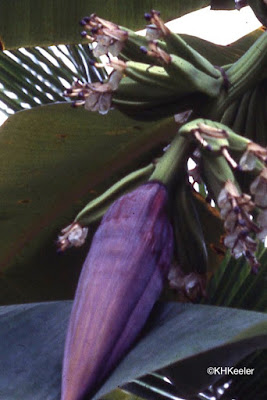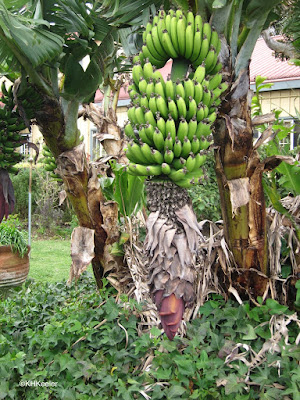Banana plants cannot survive a touch of frost, and yet banana fruits are found in markets all over the world, in the depths of winter. More bananas are traded internationally than any other fruit, selling 30% more tons than then next fruit, apples.
Bananas have been grown by people for thousands of years, likely almost 7,000 years. They are native to southeast Asia, but were so long ago domesticated, hybridized and traded that even the experts say "No good dates can be assigned to the early evolution and migrations of bananas." (Simmonds 1995). They were spread all across Asia (see previous post link) and the Pacific Islands long ago and reached Africa maybe 2,000 years ago. Bananas grown in north Africa were eaten in ancient Rome.
Early in the 16th century they were first planted in tropical America. There, they had no natural enemies and grew very well. Today, the South and Central America dominate world banana exports.
Banana plants are called trees, but they are really just very big herbs. The botanical distinction is that trees have wood, a complex and particular structure (links: about wood, wood, what is wood). Bananas do not. See photos. Banana plants can grow very tall (27 feet, 9 m) but the trunk that supports them is a pseudostem (technical term) formed of the rolled bases of all the leaves.
Banana leaves can be impressively large, to 9 feet long and 2 feet wide.
Centuries ago, growers developed plants with the seeds so reduced they are just dark dots in the white fruit. Lacking seeds, cultivated bananas have to be propagated from suckers or cuttings. This has the benefit of creating uniform fruit quality and the disadvantage of making all the plants susceptible to the same diseases since they are genetically identical (clones).
 |
| bananas, note the small plants (suckers) |
Bananas are monocotyledons, in the same major plant group as grasses. Visualizing of them as huge tropical grasses is, while probably horrifying to a botanical purist, a whole lot closer to the situation than thinking of them as trees such as apple, oak or banyan (fig).
 |
| Lower: male banana flower; Above: female flowers |
Banana terminology is fun. The big bunch of fruit is called a stem. Within the stem (bunch) a cluster of fruits is a hand. Within the hand, individual fruits are called fingers. As you can see even in my pictures, a bunch can contain several hands and each hand have as more than a dozen fingers. Don't miss telling someone you are eating a finger next time you bite into a banana.
The importance of bananas is hard to overstate. They are the Number One fruit traded in the world. They are very important to the economies of the countries that are major world banana exporters, for example, Ecuador, the Philippines, Costa Rica, Colombia, Guatemala. (The data I have is from 2013 and the market shares are changeable).
Bananas are one of the most profitable items in grocery stores in the U.S. and Europe and therefore make a substantial contribution to store income.
Bananas are critically important across Africa, although Africa doesn't export many bananas. Africans eat more bananas per capita than anyone else in the world. They grow multiple varieties and use them ripe, cooked, and fermented as beer.
Bananas are nutritious. They contain a good combination of sugars and starches, as well as being a reliable source of potassium and vitamin C. Another virtue of bananas is that they will produce fruit all year long. Furthermore, banana plants produce more fruit per plant than just about any other plant.
There are hundreds of varieties of banana, differing in firmness, starchiness, sweetness, etc. Consequently bananas are eaten fresh (as a fruit, in salads, in desserts), fried, baked, roasted, cooked into desserts, and more. Simply mashed, they make excellent baby food.
We get very few banana varieties here in the northern United States. We call bananas to be eaten fresh "bananas," and call the starchy ones to be cooked "plantains." However, the distinction only works if you have only a couple of banana varieties. Many banana varieties can be eaten and enjoyed either fresh or cooked.
The Oxford English Dictionary reports the word banana as coming into English from Portuguese or Spanish, both of which say banana, and, according to the OED, they got from the name used in Guinea (Congo) in Africa. Most European languages say some form of "banana." And yet, it is ndizi in Swahili, dikó:ndi in the Munukutuba language of the Congo-Brazzaville, banana in Wolof of Senegal, pisang in Malay, kluai in Thai, banana in Javanese, kelaa in Hindi, mai'a in Hawaiian, jiao in Chinese and banana in Japanese (see a very long list: link). The trail of the name around the world may be as interesting as the path of the plants.
Whatever you call them, worldwide bananas are a popular, versatile fruit.
 |
| Excellent use of bananas: wrapped in sweet roti and fried, ice cream on top |
Comments and corrections welcome.
References
Bynam, H. and Bynam W. 2014. Remarkable Plants That Shape Our World. The University of Chicago Press, Chicago. print.
National Geographic. 2008. Edible, an illustrated guide to the world's food plants. National Geographic Society, Washington D.C. print
Oxford English Dictionary. "Banana, n" accessed 2/20/16
Sanders, A. How tall is a banana tree? http://homeguides.sfgate.com/tall-banana-tree-54933.html Accessed 2/20/16.
Simmonds, N. W. 1995. Bananas Musa (Musaceae) pp 370-375 In J. Smartt and N. W. Simmonds. Evolution of Crop Plants 2nd edition. Longman Scientific and Technical, London. print.
Statistica.com Global fruit production in 2013, by variety (in million metric tons). http://www.statista.com/statistics/264001/worldwide-production-of-fruit-by-variety/ Accessed 2/20/16.
Valder, P. 1999. The Garden Plants of China. Timber Press, OR. print.
Van Wyk, B-E. 2005. Food Plants of the World. Timber Press, OR. print.
Vaughan, J. G. and C. A. Geissler. 1997. The New Oxford Book of Food Plants. Oxford University Press, Oxford. print.
Buy the Book! Give it as a gift! This story and thirteen other plants from around the world are told in Curious Stories of Familiar Plants from Around the World. Available on Amazon link
Kathy Keeler
Kathy Keeler
More at awanderingbotanist.com
Join me on Facebook: https://www.facebook.com/AWanderingBotanist




Hello Kathieen,
ReplyDeleteThe Article on Bananas, Everybody's Fruit in Ramgarh Block of Uttarakhand its very informative.It give detail information along with picture. Thanks for Sharing the informative Article about it fruitsgogo app
This comment has been removed by the author.
ReplyDelete